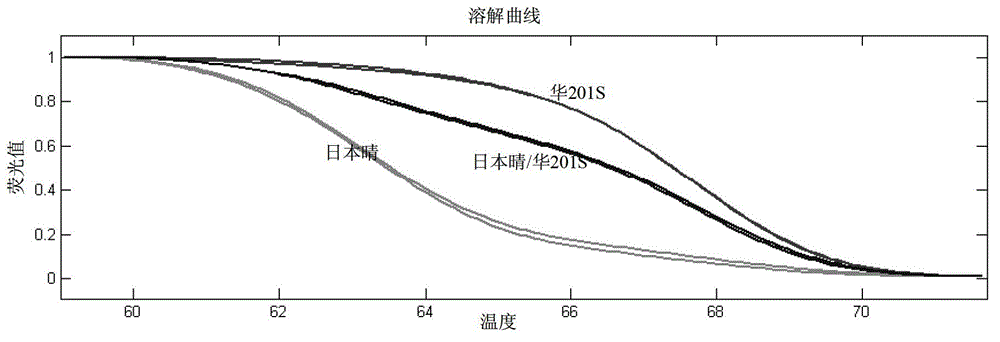Primer applied to rice photosensitive male nucleic male sterility gene lncR parting and application thereof
A rice and gene technology, applied in the field of agricultural bioengineering, can solve the problems of restricting the size of the selectable population, restricting breeding, short sunshine, etc., and achieve the effect of improving the efficiency of variety selection, accelerating the breeding process, and good primer specificity
- Summary
- Abstract
- Description
- Claims
- Application Information
AI Technical Summary
Problems solved by technology
Method used
Image
Examples
Embodiment 1
[0066] Example 1 Development of Rice Photosensitive Sterile Gene Functional Molecular Marker
[0067] 1. Functional CAPS molecular markers to distinguish photosensitive sterility from wild-type alleles
[0068] Ding et al. (Ding et al. PNAS, 2012, 109: 2654-2659) and Zhou et al. Dwarf 64S photosensitive nuclear male sterility (PGMS) is caused by a mutation of base 789 C→G in a gene encoding long non-coding RNA (lncR).
[0069] The lncR allele carried by the photosensitive sterile rice derived from Nongken 58S was named lncR g , the non-photosensitive rice allele is named lncR c . Accordingly, download the corresponding nucleotide sequence from the Gramene website (http: / / www.gramene.org / ), as shown in SEQ ID NO.1, and use Primer Premier5.0 software to design a pair of The fragment amplified by PCR primers contains the C→G mutation site.
[0070] The base sequence of the primer is:
[0071] Upstream primer (LR-F): 5'-ATCCCACAAATCCTTTAGCA-3';
[0072]Downstream primer (LR...
Embodiment 2
[0082] Example 2 Using CAPS Molecular Markers to Distinguish Photosensitive Sterile and Non-photosensitive Sterile Rice Varieties
[0083] Different rice materials were collected in 2012, including homozygous photosensitive sterile lines, heterozygous materials containing photosensitive sterile genes, and non-photosensitive sterile materials. These materials were planted in the experimental farm of Zhejiang University in the summer of 2012, and the leaves were taken from the plants in the vegetative growth stage in the field for use.
[0084] 1. Extraction of rice genomic DNA
[0085] (1) Cut the rice leaves into pieces and put them in a 2.0mL centrifuge tube, put a steel ball into them at the same time, and grind them with a tissue mill;
[0086] (2) Add 800μL CTAB extraction buffer (Tris-HCl, 100mM, pH8.0; EDTA, 20mM, pH8.0; NaCl, 500mM; CTAB, 2%), 65℃ water bath for 40min, shake 3-4 times during the period;
[0087] (3) Add an equal volume of chloroform: isoamyl alcohol (...
Embodiment 3
[0101] Example 3 Using HRM Molecular Markers to Distinguish Photosensitive Sterile and Non-photosensitive Sterile Varieties
[0102] 1. Extraction of rice genomic DNA
[0103] For the method, refer to the extraction of rice genomic DNA in Example 2.
[0104] 2. PCR amplification
[0105] Using rice DNA as a template, using the primers LR-F, LR-R and probe primers designed in Example 1, asymmetric PCR amplification was performed.
[0106] When used to develop HRM molecular markers, asymmetric PCR amplification is generally carried out in a volume of 10 μl, and the reaction solution includes PCR buffer, MgCl 2 , dNTP, Taq DNA polymerase, primers, total DNA of rice samples, sterile water, etc. In addition to conventional components, it is necessary to add saturated fluorescent dyes (such as LC Green) before PCR, and cover the reaction mixture with mineral oil (Sigma), and , in order to avoid affecting the PCR amplification, it is also possible to add a saturated fluorescent dy...
PUM
 Login to View More
Login to View More Abstract
Description
Claims
Application Information
 Login to View More
Login to View More - Generate Ideas
- Intellectual Property
- Life Sciences
- Materials
- Tech Scout
- Unparalleled Data Quality
- Higher Quality Content
- 60% Fewer Hallucinations
Browse by: Latest US Patents, China's latest patents, Technical Efficacy Thesaurus, Application Domain, Technology Topic, Popular Technical Reports.
© 2025 PatSnap. All rights reserved.Legal|Privacy policy|Modern Slavery Act Transparency Statement|Sitemap|About US| Contact US: help@patsnap.com



